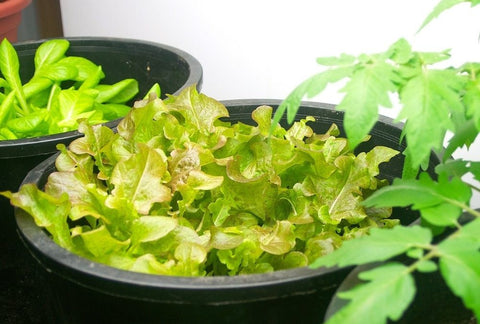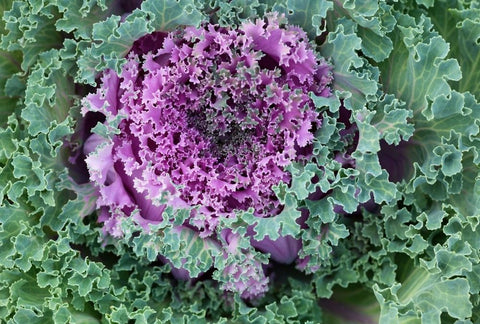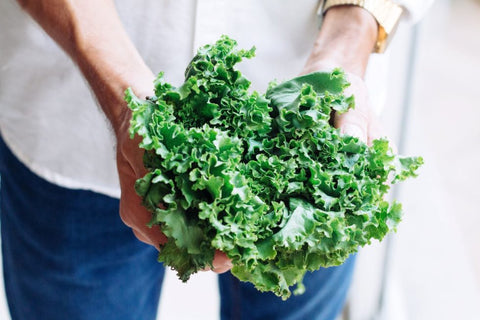Easy, fast-growing, and delicious fresh – Lettuce is one of the most rewarding plants to grow indoors and pick fresh for each salad.

Timing
Sprouts in 1-2 weeks. Harvest from Month 2+ on.

Part sun
Equivalent of 4+ hours of direct sun (DLI of 12+ mol/m²/day).

Care
Beginner friendly. You’ll sprout, thin, and harvest.
Best Lettuce to Grow Inside
There are over 800 varieties recognized in the US alone – so take these recommendations for just the start as you explore the colors, shapes, and flavors of all the different varieties. There are 4 broad categories – and while they can be grown indoors – some work much better than others.
Growing Butterhead Lettuce Indoors
Butterheads are our favorite type of lettuce to grow indoors. They form a rosette of tender small leaves around a loose center. There are plenty of varieties that are tolerant of a little heat, and you can keep them producing for a long time.
Growing Crisphead Lettuce Indoors
Crisphead is our least favorite way to grow indoors. Also known as the firm head, types of lettuce grow as large tight balls (think iceberg lettuce), and are slow and temperamental.
Growing Romaine Lettuce Indoors
Romaine grows as long narrow crisp leaves but tends to not be very heat tolerant. They can be good to grow in winter – but most windows get too hot in the summer for them to thrive.
Growing Loose Leaf Lettuce Indoors
Loose-leaf does not form any head shape – just lots of (typical oval) leaves. They tend to be quick growing, and are a pretty efficient use of space – just pick one leaf at a time. Like romaine, they can go limp in dry winter environments. They are also not quite as tidy as the head-type lettuce but are still perfectly suitable for indoors especially if you’ve got a larger surface area.
Little Gem
Butterhead
Sweet and compact, this lettuce is just as it’s named! It’s crisp and fresh, perfect for any salad, and great grilled. In just over a month and a half, you’ll have leaves growing. Some say it’s the most delicious lettuce. See for yourself!
Urban LeafSummer Crisp
Butterhead
Summer Crisp Varieties have a good flavor and crunch and are able to stand up to a bit of heat as well as to dry winters.
AmazonMini-Romaine Trio
Romaine
Romaine is sweet and has a nice texture – this trio has a nice range of red and green colors – all in a compact head.
AmazonSalad Bowl
Loose Leaf
The salad bowl is classic apple-green lettuce. Its crisp, tender, deeply-lobed leaves impart sweet flavor and fragrance
AmazonBest Setup for Lettuce Plants
You’ll need:
Planter:
Ceramic Self Watering Planter or Hydroponic or pot that is at least 6″ / 1 quart.
Soil:
Standard Potting Mix
Plant Food:
Balanced Blend. This should be equal parts nitrogen, phosphorus, and potassium (with NPK numbers like 10-10-10).
Grow Light:
A strong grow light that can give the equivalent of 4+ hours of direct sun (DLI of 12+ mol/m²/day).
Jump to: Our product recommendations
Preparing your Planter & Watering Schedule for Lettuce
Lettuce plants do well in moist soil conditions. If the soil dries out completely the roots will die back and it will be tough for the plant to recover. On the other hand, if the roots are exposed to standing water for too long, they can rot. Lettuce does fantastically in a hydroponic setup or in Self Watering Planters.
We prefer a Ceramic Self Watering Planter filled with a standard potting mix that self-regulates to keep the soil at consistent moisture for your plant to thrive (and no watering guesswork for you).
To set one up:

- Fill up the planter with dry soil from the bag, gently tamping down the top.
- Dump the soil into a large mixing bowl and add water until the soil is moist, but not sopping wet (about ½ Cup).
- Mix in 1 tablespoon of the Balanced Blend Plant Food.
If you are using a regular pot instead, it should be a little bit bigger (at least 6″ / 1 quart) and will need drainage holes to prevent it from being overwatered. Let the top of the soil dry out between watering.
Starting your Lettuce: Seed vs Propagate
New Lettuce plants can be started from seed (preferred), propagated from an established plant, or purchased live at many garden centers. We like starting from seed the best because it’s quicker than propagating from a cutting, less expensive than using live starters, has tons of options, and there’s no way unexpected visitors (pests!) are riding along.
How to Plant Lettuce Seeds

Lettuce grows quickly from seed. Plant 2 sites in a 6″ / 1-quart container. In larger containers, space sites 3″ apart. For each site press 2 seeds into the surface. Keep the soil warm (40-80°F, ideally 70°F). Sprouts typically appear in 7 days but can be as quick as 2 days or as long as 10 days depending on your conditions.
How to Transplant Lettuce

Live starter plants give you a little jump start on your first harvest. When you’re in a garden center – pick the bushiest plant available (tall and lanky ones will be weak growers) and give it a good inspection for pests. Leaves should be dark green without holes, spots, or curled edges. A best practice is to actually “quarantine” your plant for about a week after bringing it home to make sure it’s free and clear of ride-on pests.
- Remove some soil from its final planter – leaving enough space for the bottom of the seedling to be just higher than the soil surface.
- Hold on to the base of the stem with one hand, and turn the pot over while gently pulling the seedling. Giving the pot a few squeezes can help dislodge it.
- Place in its final container and fill around it with soil so that it’s tight, but not compacted.
Where to Grow Your Lettuce Plants
Out of all edible plants, Lettuce plants have some of the lowest light needs – but they still need to be in a very bright place that gets at least 4+ hours of direct sunshine. While you might be lucky enough to have a bright windowsill that works, most of us need to use a grow light (especially during the winter). For an introduction to grow lights, head over to our post on grow lights for indoor gardeners. We’ve also got a buying guide for screw-in types, but to keep things simple in this guide, we’ll just provide directions for the 24W Screw-in Bulb by Sansi, which we think is a good middle-of-the-road option.

How Bright Should Your Grow Light Be?
Lettuce plants need the equivalent of 4+ hours of direct sunlight [DLI of 12+ mol/m²/day] to grow their best. In order to provide an equivalent amount with a grow light, it needs to be pretty bright! The 24W Sansi bulb should be placed 6 inches away from the top of the plant. This will give your PPFD (the standard measure of brightness) of 500 μmol/m²/s.
How Many Hours Per Day Do Your Lettuce Plants Need Under a Grow Light?
Lettuce plants are known as “long-day” plants. When they sense over 12 hours of light per day, they’ll start the end of their lifecycle and work on making seeds. We want to keep them in an earlier stage so we can keep harvesting the leaves, so we recommend setting up a timer to leave it on for only 8 hours per day.
Extend Your Harvest by Keeping the Temperatures Cool
Lettuce is known as a “cool weather crop.” If it senses warming temperatures it will “bolt” – send up flowers and become bitter in the process. Where you plant them can have some effect on the temperature – lower positions on a growing rack, ceramic planters, and hydroponics with air bubblers tend to run cooler. It’s best to avoid windows that get really hot (like bay windows).
Week 1-2: Check for Sprouts
You could see seedlings in as little as 2 days (though 7 days is more typical). If it’s been 10 days and you still don’t have any sprouts, it’s likely that your setup is too cold.
Week 3: Check Your Seedlings
There’s no need to thin Lettuce, but you should check on your seedlings’ progress to make sure you’ve got enough light. They should be about 1 inch tall by the end of Week 3. If they aren’t you likely need a bit more light.
Week 5: How to Prune Lettuce

You’ll notice how all the stems and leaves of Lettuce grow from a single, central point (called radial growth). The plant puts out new leaves in the center and pushes old leaves outward, getting bigger and bushier over time. Pruning and harvesting are one-in-the-same with Lettuce. Once the plant has at least 3 separate stems coming from the base, take one of the outside leaves and cut it close to the base (½” above is fine). It’s good to leave at least 2/3rds of the plant left to regrow.
Month 2+: How to Harvest Lettuce
Just cut the lettuce at the base of the plant.
Month 4: End of Life
Leaf lettuce is best harvested as the entire plant – so once you harvest it’s time to start over.
Shop This Blog
The right supplies can take the guesswork out of caring for your plants – and turn care from a daily to weekly routine. Through our grow tests, we’ve found these products to produce the best indoor Lettuce (and also have simple maintenance). Plants are adaptable and can grow in many different conditions, so they are by no means necessary if you already have other supplies.
Best Containers for Lettuce: Ceramic Self Watering Planters
Plants thrive on consistent moisture but can suffer if they’re waterlogged. A semi-porous ceramic self-regulates ideal conditions. Our favorite is the COSWIP planter. Runner up is XS Self Watering Planter by Wet Pot.
Best Soil for Lettuce: Standard Potting Mix
Lettuce likes a rich and moist root zone – so you are best off with a standard potting mix – we like this Potting Mix by Rosy Soil.
Best Nutrients for Lettuce: Balanced Blend
Lettuce likes nutrients that are equal parts nitrogen, phosphorus, and potassium (with NPK numbers like 10-10-10). For a Balanced Blend, we recommend: Dr Earth All Purpose.
Best Light for Lettuce: DIY or Soltech
There is a very small chance that you have the bright windows needed to grow these without a grow light. If you are looking for a higher-end option – we love the Aspect Light by Soltech. For a more affordable option, a DIY setup using a 24W Screw-in Bulb by Sansi with a Clamp Light and Mechanical Timer works well too. Check out our complete guide on a DIY setup for less than $40 or our buying guide for screw-in bulbs.








There are no comments for this article. Be the first one to leave a message!